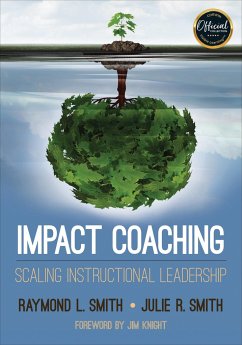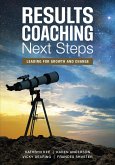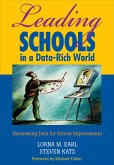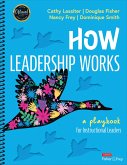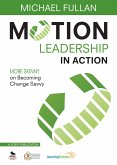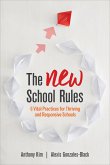- Broschiertes Buch
- Merkliste
- Auf die Merkliste
- Bewerten Bewerten
- Teilen
- Produkt teilen
- Produkterinnerung
- Produkterinnerung
This solid, sustainable, and laser-sharp focus on instructional leadership helps leaders hone, model and lead new learning through deliberate practice.
Andere Kunden interessierten sich auch für
![Results Coaching Next Steps Results Coaching Next Steps]() Kathryn M. KeeResults Coaching Next Steps46,99 €
Kathryn M. KeeResults Coaching Next Steps46,99 €![Leading Schools in a Data-Rich World Leading Schools in a Data-Rich World]() L Earl / S KatzLeading Schools in a Data-Rich World26,99 €
L Earl / S KatzLeading Schools in a Data-Rich World26,99 €![Values for Educational Leadership Values for Educational Leadership]() Graham HaydonValues for Educational Leadership65,99 €
Graham HaydonValues for Educational Leadership65,99 €![How Leadership Works How Leadership Works]() Cathy J. LassiterHow Leadership Works46,99 €
Cathy J. LassiterHow Leadership Works46,99 €![Motion Leadership in Action Motion Leadership in Action]() Michael FullanMotion Leadership in Action27,99 €
Michael FullanMotion Leadership in Action27,99 €![The New School Rules The New School Rules]() Anthony KimThe New School Rules41,99 €
Anthony KimThe New School Rules41,99 €![Stories of Caring School Leadership Stories of Caring School Leadership]() Mark A. Smylie (USA University of Illinois at Chicago)Stories of Caring School Leadership39,99 €
Mark A. Smylie (USA University of Illinois at Chicago)Stories of Caring School Leadership39,99 €-
-
-
This solid, sustainable, and laser-sharp focus on instructional leadership helps leaders hone, model and lead new learning through deliberate practice.
Hinweis: Dieser Artikel kann nur an eine deutsche Lieferadresse ausgeliefert werden.
Hinweis: Dieser Artikel kann nur an eine deutsche Lieferadresse ausgeliefert werden.
Produktdetails
- Produktdetails
- Verlag: SAGE Publications Inc
- Seitenzahl: 216
- Erscheinungstermin: 12. Januar 2018
- Englisch
- Abmessung: 251mm x 175mm x 15mm
- Gewicht: 456g
- ISBN-13: 9781506361826
- ISBN-10: 150636182X
- Artikelnr.: 48748101
- Herstellerkennzeichnung
- Libri GmbH
- Europaallee 1
- 36244 Bad Hersfeld
- gpsr@libri.de
- Verlag: SAGE Publications Inc
- Seitenzahl: 216
- Erscheinungstermin: 12. Januar 2018
- Englisch
- Abmessung: 251mm x 175mm x 15mm
- Gewicht: 456g
- ISBN-13: 9781506361826
- ISBN-10: 150636182X
- Artikelnr.: 48748101
- Herstellerkennzeichnung
- Libri GmbH
- Europaallee 1
- 36244 Bad Hersfeld
- gpsr@libri.de
Dr. Julie R. Smith is a thirty-five year veteran educator, speaker, consultant, and author. Her passion, area of focus, and expertise is in building leadership capacity within people and systems; school improvement planning, and teacher, principal, and district evaluation models. Dr. Smith continues her learning by providing workshops in North America and Canada around Professor John Hattie's research in Visible Learning as a Visible LearningPlus Consultant with Corwin. She is also trained to provide workshops in Dr. James Popham's research around designing and implementing defensible teacher evaluation programs and Dr. Russ Quaglia's Student Voice and Aspiration Framework. She most recently co-authored Evaluating Instructional Leadership: Recognized Practices For Success (2015).
Foreword by Jim Knight
Preface
Retain Your Investment in Leadership
Promote Continuous Learning
Where Do Impact Coaches Come From?
Special Features
Who Is This Book For?
Introducing Rachel Hazel, Featured Coachee
Acknowledgments
About the Authors
Chapter 1: Why Do School Leaders Need Coaching?
The Dubious Quality of Traditional Professional Development
Common Forms of Coaching
Research on Leadership Coaching
Key Takeaways
Going Deeper
Chapter 2: Leveraging Your Five Big-Winner Leadership Practices
The 80/20 Rule
High-Impact Instructional Leadership Practices
Key Takeaways
Going Deeper
Chapter 3: What Does Impact Coaching Look Like?
The Impact Coaching Cycle
Key Takeaways
Going Deeper
Chapter 4: Partnership Principles and Theories of Practice
Knight's Partnership Principles
Theories of Practice
Key Takeaways
Going Deeper
Chapter 5: Impact Partner Communication
Why Conversations About Improvement Can Be Difficult
Conducting Open-to-Learning Conversations
Key Components of an Open-to-Learning Conversation
Engaging in Behaviors That Mediate Thinking
Key Takeaways
Going Deeper
Chapter 6: Engaging School Leaders and Starting the Journey
Getting School Leaders Amenable to Coaching
Making Change Happen: Hall and Hord
Key Functions of Change and Professional Learning in Schools
The Components of Impact Coaching
Key Takeaways
Going Deeper
Chapter 7: Modeling, Observing, and Collaboratively Exploring Data
Impact Coaching Process Tools
Key Takeaways
Going Deeper
Chapter 8: The End of Impact Coaching: Scaling Instructional Leadership
What Do We Now Know?
Learning About Impact Coaching During Coaching
Our Challenge to You
Appendices
Section 1: Feedback Cue Card
Section 2: Instructional Leadership Elements Rubrics
Section 3: LinkingWalk Evidence-Gathering Templates
Section 4: Theories-of-Practice Self-Assessment Tool
Glossary
References
Index
Preface
Retain Your Investment in Leadership
Promote Continuous Learning
Where Do Impact Coaches Come From?
Special Features
Who Is This Book For?
Introducing Rachel Hazel, Featured Coachee
Acknowledgments
About the Authors
Chapter 1: Why Do School Leaders Need Coaching?
The Dubious Quality of Traditional Professional Development
Common Forms of Coaching
Research on Leadership Coaching
Key Takeaways
Going Deeper
Chapter 2: Leveraging Your Five Big-Winner Leadership Practices
The 80/20 Rule
High-Impact Instructional Leadership Practices
Key Takeaways
Going Deeper
Chapter 3: What Does Impact Coaching Look Like?
The Impact Coaching Cycle
Key Takeaways
Going Deeper
Chapter 4: Partnership Principles and Theories of Practice
Knight's Partnership Principles
Theories of Practice
Key Takeaways
Going Deeper
Chapter 5: Impact Partner Communication
Why Conversations About Improvement Can Be Difficult
Conducting Open-to-Learning Conversations
Key Components of an Open-to-Learning Conversation
Engaging in Behaviors That Mediate Thinking
Key Takeaways
Going Deeper
Chapter 6: Engaging School Leaders and Starting the Journey
Getting School Leaders Amenable to Coaching
Making Change Happen: Hall and Hord
Key Functions of Change and Professional Learning in Schools
The Components of Impact Coaching
Key Takeaways
Going Deeper
Chapter 7: Modeling, Observing, and Collaboratively Exploring Data
Impact Coaching Process Tools
Key Takeaways
Going Deeper
Chapter 8: The End of Impact Coaching: Scaling Instructional Leadership
What Do We Now Know?
Learning About Impact Coaching During Coaching
Our Challenge to You
Appendices
Section 1: Feedback Cue Card
Section 2: Instructional Leadership Elements Rubrics
Section 3: LinkingWalk Evidence-Gathering Templates
Section 4: Theories-of-Practice Self-Assessment Tool
Glossary
References
Index
Foreword by Jim Knight
Preface
Retain Your Investment in Leadership
Promote Continuous Learning
Where Do Impact Coaches Come From?
Special Features
Who Is This Book For?
Introducing Rachel Hazel, Featured Coachee
Acknowledgments
About the Authors
Chapter 1: Why Do School Leaders Need Coaching?
The Dubious Quality of Traditional Professional Development
Common Forms of Coaching
Research on Leadership Coaching
Key Takeaways
Going Deeper
Chapter 2: Leveraging Your Five Big-Winner Leadership Practices
The 80/20 Rule
High-Impact Instructional Leadership Practices
Key Takeaways
Going Deeper
Chapter 3: What Does Impact Coaching Look Like?
The Impact Coaching Cycle
Key Takeaways
Going Deeper
Chapter 4: Partnership Principles and Theories of Practice
Knight's Partnership Principles
Theories of Practice
Key Takeaways
Going Deeper
Chapter 5: Impact Partner Communication
Why Conversations About Improvement Can Be Difficult
Conducting Open-to-Learning Conversations
Key Components of an Open-to-Learning Conversation
Engaging in Behaviors That Mediate Thinking
Key Takeaways
Going Deeper
Chapter 6: Engaging School Leaders and Starting the Journey
Getting School Leaders Amenable to Coaching
Making Change Happen: Hall and Hord
Key Functions of Change and Professional Learning in Schools
The Components of Impact Coaching
Key Takeaways
Going Deeper
Chapter 7: Modeling, Observing, and Collaboratively Exploring Data
Impact Coaching Process Tools
Key Takeaways
Going Deeper
Chapter 8: The End of Impact Coaching: Scaling Instructional Leadership
What Do We Now Know?
Learning About Impact Coaching During Coaching
Our Challenge to You
Appendices
Section 1: Feedback Cue Card
Section 2: Instructional Leadership Elements Rubrics
Section 3: LinkingWalk Evidence-Gathering Templates
Section 4: Theories-of-Practice Self-Assessment Tool
Glossary
References
Index
Preface
Retain Your Investment in Leadership
Promote Continuous Learning
Where Do Impact Coaches Come From?
Special Features
Who Is This Book For?
Introducing Rachel Hazel, Featured Coachee
Acknowledgments
About the Authors
Chapter 1: Why Do School Leaders Need Coaching?
The Dubious Quality of Traditional Professional Development
Common Forms of Coaching
Research on Leadership Coaching
Key Takeaways
Going Deeper
Chapter 2: Leveraging Your Five Big-Winner Leadership Practices
The 80/20 Rule
High-Impact Instructional Leadership Practices
Key Takeaways
Going Deeper
Chapter 3: What Does Impact Coaching Look Like?
The Impact Coaching Cycle
Key Takeaways
Going Deeper
Chapter 4: Partnership Principles and Theories of Practice
Knight's Partnership Principles
Theories of Practice
Key Takeaways
Going Deeper
Chapter 5: Impact Partner Communication
Why Conversations About Improvement Can Be Difficult
Conducting Open-to-Learning Conversations
Key Components of an Open-to-Learning Conversation
Engaging in Behaviors That Mediate Thinking
Key Takeaways
Going Deeper
Chapter 6: Engaging School Leaders and Starting the Journey
Getting School Leaders Amenable to Coaching
Making Change Happen: Hall and Hord
Key Functions of Change and Professional Learning in Schools
The Components of Impact Coaching
Key Takeaways
Going Deeper
Chapter 7: Modeling, Observing, and Collaboratively Exploring Data
Impact Coaching Process Tools
Key Takeaways
Going Deeper
Chapter 8: The End of Impact Coaching: Scaling Instructional Leadership
What Do We Now Know?
Learning About Impact Coaching During Coaching
Our Challenge to You
Appendices
Section 1: Feedback Cue Card
Section 2: Instructional Leadership Elements Rubrics
Section 3: LinkingWalk Evidence-Gathering Templates
Section 4: Theories-of-Practice Self-Assessment Tool
Glossary
References
Index

